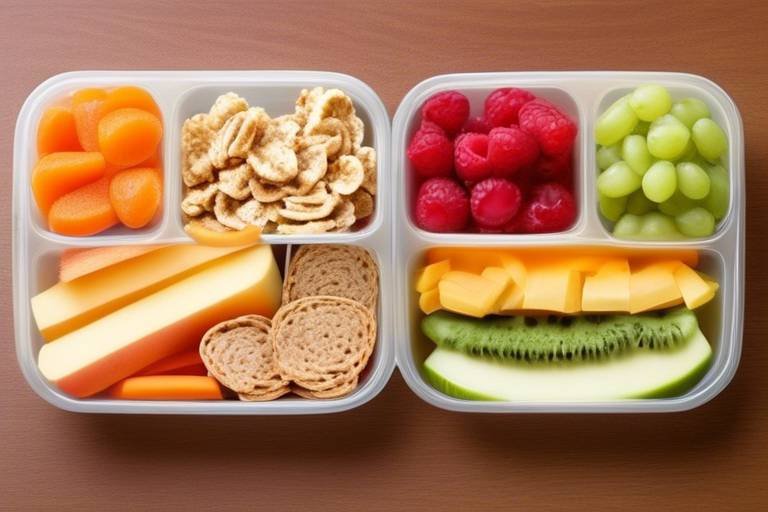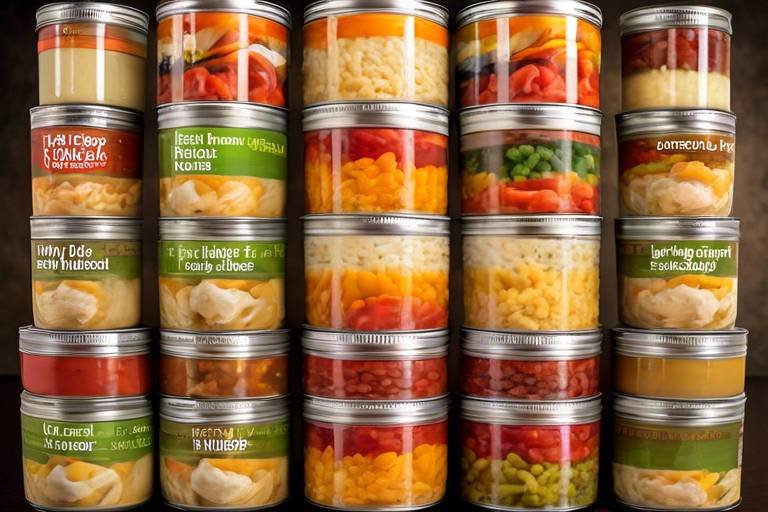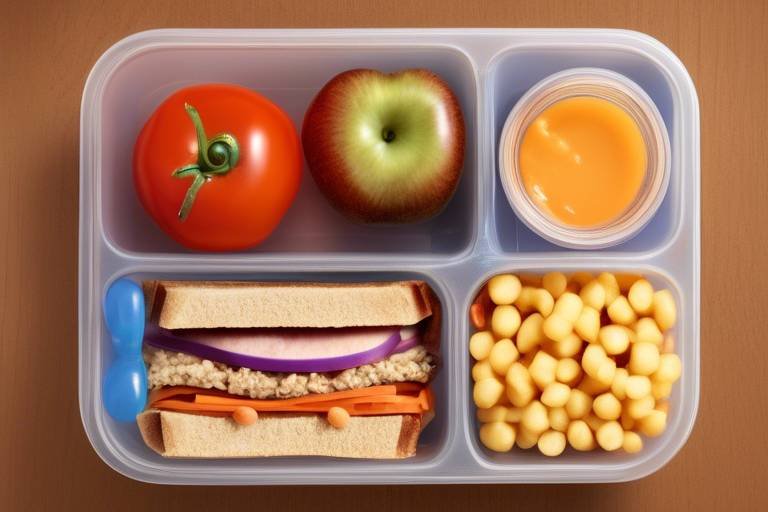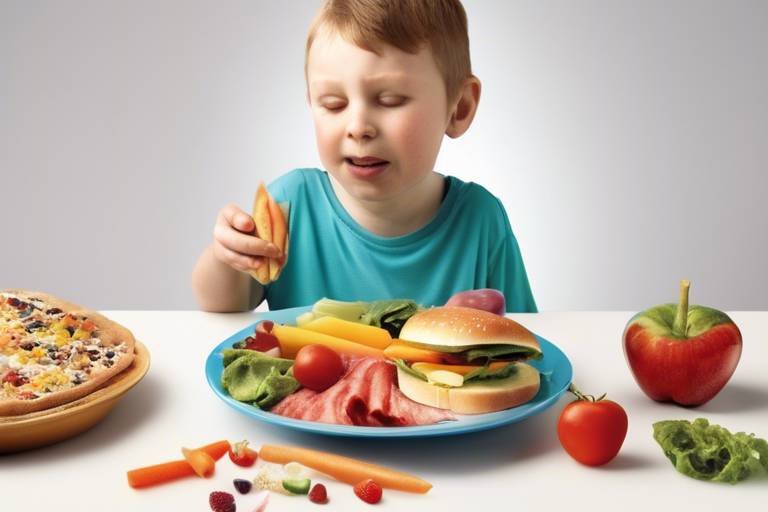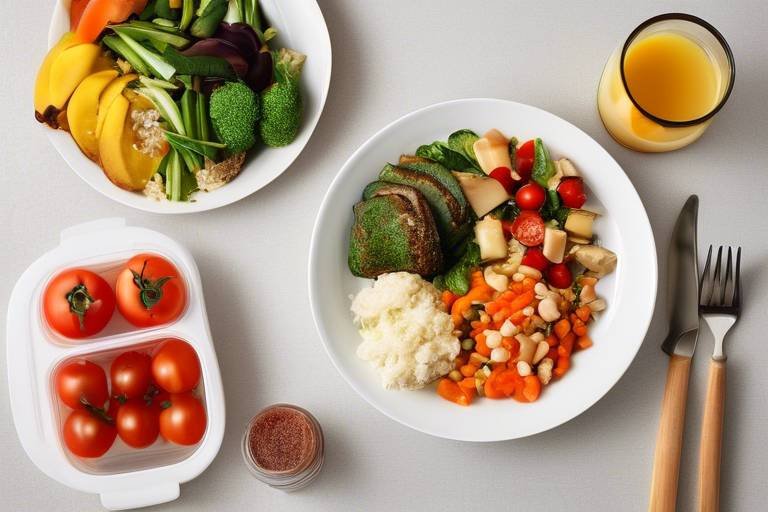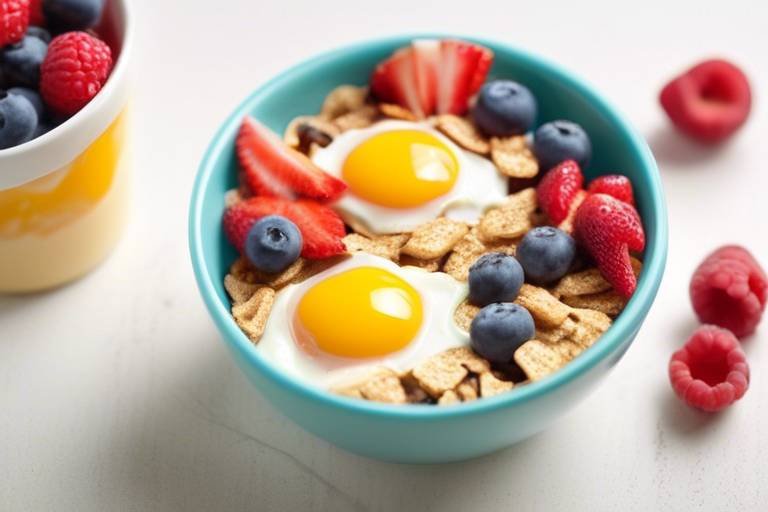Nutritious Food Swaps to Curb Your Child's Sweet Tooth
As parents, we all want the best for our children, especially when it comes to their health and nutrition. However, navigating the world of snacks can feel like walking through a minefield, particularly when it comes to sugary treats that seem to call out to our little ones. But fear not! This article explores healthier alternatives to sugary snacks, offering practical tips for parents to help their children enjoy delicious yet nutritious options that satisfy cravings without compromising health. By making small, thoughtful changes in their snack choices, we can create a positive impact on their overall well-being.
Before we dive into the scrumptious alternatives, it’s essential to understand just how much sugar can affect our kids. Excessive sugar consumption can lead to a plethora of issues, including obesity, dental problems, and even behavioral changes. Think about it: when children consume too much sugar, they often experience a quick spike in energy followed by a crash, leaving them irritable and restless. This rollercoaster effect can disrupt their mood and focus, making it harder for them to concentrate in school. By making informed dietary choices, we can help our children thrive both physically and mentally.
Now that we’re on the same page about the effects of sugar, let’s explore some delightful and nutritious snack options that can replace those traditional sugary treats. The goal here is to ensure your child enjoys flavorful and satisfying bites while benefiting from essential nutrients. Here are some fantastic alternatives that you can easily incorporate into your child's diet:
One of the best ways to satisfy a sweet tooth is by turning to fruits. Not only are they naturally sweet, but they also come packed with vitamins, minerals, and fiber. Think of fruits as nature's candy! Here are a couple of ideas:
Why not whip up a delicious fruit smoothie? By blending different fruits with yogurt, you can create a refreshing drink that’s not only tasty but also nutritious. For example, a banana and spinach smoothie with a splash of almond milk can be a hit. It’s a great way to sneak in some greens while satisfying your child's sweet cravings without added sugars.
When it comes to snacking, dried fruits can be a fantastic substitute for traditional candies. They offer that chewy texture and sweetness that kids love, but with nutritional advantages. For instance, dried apricots and raisins are rich in fiber and antioxidants. So, next time your child reaches for a pack of gummy bears, consider offering them a handful of dried fruits instead. It’s a sweet swap that they won’t even notice!
Another excellent way to control what your child consumes is by making homemade treats. This way, you can ensure that the ingredients are wholesome and nutrient-dense. Think of it as crafting your own delicious masterpieces! Simple recipes for energy balls made with oats, nut butter, and a hint of honey can be a fun activity to do together. Plus, they make for a perfect on-the-go snack!
Whole grains are another essential component of a healthy diet. By swapping refined grains for whole grains, we can provide our children with sustained energy and essential nutrients. Whole grains are like the sturdy foundation of a house; they support everything else. They help with digestion and keep kids fuller for longer, making them less likely to reach for sugary snacks.
There are plenty of whole grain snacks available that can replace sugary options. Look for whole grain crackers or popcorn seasoned with herbs instead of butter. These snacks not only taste great but also promote better digestion and overall health. You can even make your own popcorn at home for a fun movie night!
Breakfast is the most important meal of the day, and it’s a perfect opportunity to incorporate whole grains. Think oatmeal topped with fresh fruits and a sprinkle of cinnamon or whole grain pancakes made with mashed bananas. These meals set a nutritious tone for the day while satisfying sweet cravings with natural ingredients.
Q: How can I encourage my child to try healthier snacks?
A: Start by involving them in the process! Let them pick out fruits or help make smoothies. Making it a fun activity can spark their interest.
Q: Are there any store-bought snacks that are healthy?
A: Yes! Look for snacks that have whole grains as the first ingredient and minimal added sugars. Always check the nutrition label.
Q: How can I make healthy snacks more appealing?
A: Presentation is key! Use colorful plates, cut fruits into fun shapes, or create a snack platter with a variety of options to keep things exciting.

Understanding Sugar's Impact on Children
When it comes to our little ones, we often want to give them the best. But have you ever stopped to think about what all that sugar in their diets is really doing to their bodies and minds? Sugar can be a sneaky villain in children’s health, lurking in everything from their favorite candies to seemingly innocent snacks. Research shows that excessive sugar consumption can lead to a myriad of health issues, including obesity, diabetes, and even behavioral problems. These sugary treats may provide a quick energy boost, but they can also result in a significant crash, leaving your child feeling lethargic and irritable.
Moreover, the impact of sugar goes beyond just physical health. Studies have indicated that high sugar intake can affect a child’s mood and cognitive functions. Imagine a rollercoaster ride—one minute they’re soaring high, full of energy, and the next they’re plummeting down, feeling tired and cranky. This cycle can make it hard for kids to concentrate in school, leading to poor academic performance. As parents, it’s crucial to understand these effects and make informed dietary choices to foster better health and behavior.
But how do we tackle this sweet monster? First, it's essential to recognize where sugar is hiding in your child's diet. Here’s a quick breakdown of common sources of added sugars:
- Sodas and sugary drinks: These can pack a punch with high sugar content and empty calories.
- Candy and sweets: Obvious culprits, but also consider how often they're consumed.
- Processed snacks: Many snacks marketed as healthy can still contain hidden sugars.
- Breakfast cereals: Some cereals can contain more sugar than dessert.
Understanding these sources is the first step in making healthier choices. By reducing sugar intake, you can help your child maintain a balanced diet, which is vital for their growth and development. So, let’s take a closer look at how we can swap out those sugary snacks for healthier, more nutritious options that still satisfy their cravings!

Healthy Snack Alternatives
As parents, we all want our kids to enjoy their snacks without compromising their health. The good news is that there are plenty of that can replace those sugary treats your children may be craving. It's all about being creative and finding options that are both nutritious and delicious. Imagine swapping out that sugary granola bar for a homemade energy bite packed with oats, nuts, and a hint of honey. Not only will your child be satisfied, but you can feel good knowing they’re fueling their bodies with wholesome ingredients.
One of the easiest ways to make healthier choices is by incorporating whole foods into your child's snacking routine. Think vibrant fruits, crunchy vegetables, and wholesome grains. For instance, instead of reaching for a bag of chips, consider offering crisp apple slices with a side of almond butter. This not only provides essential nutrients but also satisfies that crunchy craving. Another excellent option is to prepare yogurt parfaits using plain yogurt layered with fresh fruits and a sprinkle of granola. Your kids will love the colors and textures, and you can feel great about the nutritional value.
Here are a few more ideas to inspire your healthy snack game:
- Veggie Sticks with Hummus: Carrot and cucumber sticks paired with hummus make for a crunchy, satisfying snack that’s loaded with vitamins.
- Nut Butter Energy Balls: Combine oats, nut butter, and a bit of honey to create no-bake energy balls that are easy to make and perfect for on-the-go snacking.
- Cheese and Whole-Grain Crackers: A classic combo that provides protein and fiber, helping keep hunger at bay.
By making these simple swaps, you can transform your child's snacking habits into something that supports their health and well-being. Remember, it’s not just about cutting out sugar; it’s about introducing them to a world of flavors and textures that are both enjoyable and nourishing. The key is to keep things exciting and to involve your kids in the process. Let them help pick out fruits and veggies at the store or even assist in the kitchen when preparing their snacks. This not only makes snacking healthier but also fosters a sense of independence and curiosity about food.

Fruits as Natural Sweeteners
When it comes to satisfying your child's sweet tooth, fruits are nature's candy. These colorful gems are not only delicious, but they also pack a punch of essential nutrients that are crucial for your child's growth and development. Think about it: why reach for a sugary candy bar when you can indulge in a sweet, juicy piece of fruit that comes with vitamins, minerals, and fiber? It's like trading in a clunky old car for a shiny new model—one is full of empty promises, while the other is a powerhouse of goodness.
Fruits are incredibly versatile and can be enjoyed in numerous ways. You can slice up an apple, toss some berries into a bowl, or even blend them into a smoothie. The natural sugars found in fruits, such as fructose, provide a wholesome sweetness that satisfies cravings without the crash that comes from refined sugars. Plus, they help promote better digestion and overall health. Not to mention, they make for an attractive snack that’s easy to grab on the go!
Here’s a quick comparison to illustrate the benefits of fruits versus traditional sugary snacks:
| Snack Type | Calories | Sugar Content | Nutrients |
|---|---|---|---|
| Fruit (e.g., Banana) | 105 | 14g | Potassium, Vitamin C, Fiber |
| Traditional Candy (e.g., Chocolate Bar) | 210 | 24g | Minimal Nutrients |
As you can see, opting for fruits not only reduces calorie intake but also provides your child with essential nutrients that refined snacks simply can't match. The fiber in fruits helps to keep your child feeling full longer, preventing those pesky hunger pangs that often lead to unhealthy snacking.
So, how can you encourage your child to swap out candy for fruit? Start by making fruits easily accessible. Keep a bowl of fresh fruit on the kitchen counter or pack fruit slices in their lunchboxes. You can even get creative by making fruit kebabs or smoothies, which can be a fun and engaging way for kids to enjoy their daily servings of fruit. Remember, it’s all about making healthy choices feel exciting!
In conclusion, fruits are not just a substitute for sugary snacks; they are a fantastic way to introduce your child to the world of natural sweetness. By incorporating more fruits into their diet, you’re not only curbing their sweet tooth but also laying the foundation for a healthier lifestyle. After all, who wouldn't want to trade in sugary snacks for a burst of fruity goodness?

Fruit Smoothies
When it comes to satisfying your child's sweet tooth without the guilt, are a game-changer! Not only are they incredibly delicious, but they also pack a nutritional punch that can help your little ones grow strong and healthy. Imagine a drink that combines the natural sweetness of fruits with the creamy goodness of yogurt or milk—sounds tempting, right? Smoothies are versatile, allowing you to mix and match flavors, textures, and ingredients, making it easy to cater to your child's preferences.
To whip up a fantastic fruit smoothie, all you need are a few simple ingredients. Start with a base of fresh or frozen fruits such as bananas, berries, or mangoes. These fruits not only add delightful sweetness but also provide essential vitamins and antioxidants. Next, add a scoop of yogurt or a splash of milk to create a creamy texture. Yogurt is an excellent source of calcium and probiotics, which are beneficial for your child’s digestive health. You can even sneak in some spinach or kale for an extra dose of nutrients without altering the flavor too much—talk about a sneaky way to boost their veggie intake!
Here’s a quick recipe to get you started:
| Ingredients | Quantity |
|---|---|
| Banana | 1 medium |
| Frozen berries (strawberries, blueberries, etc.) | 1 cup |
| Plain yogurt | 1/2 cup |
| Milk (or a dairy alternative) | 1/2 cup |
| Honey (optional) | 1 tablespoon |
Simply blend all the ingredients together until smooth, and voilà! You have a delightful, nutritious smoothie that your child will love. The best part? You can customize it based on what fruits are in season or what you have on hand. This means you can create a new flavor combination every week, keeping things exciting and fresh!
Don’t forget to involve your child in the smoothie-making process. Let them choose their favorite fruits or even help with the blending. This not only makes them more likely to enjoy the smoothie but also teaches them the importance of making healthy choices. Plus, it’s a fun way to spend time together in the kitchen!
In conclusion, fruit smoothies are a fantastic way to curb your child's sweet cravings while ensuring they receive the essential nutrients their growing bodies need. With endless possibilities for flavors and ingredients, smoothies can become a staple in your family's diet, making healthy eating a delicious adventure!
Q: Can I use any type of fruit for smoothies?
A: Absolutely! You can use fresh, frozen, or even canned fruits (just watch out for added sugars). Popular choices include bananas, berries, mangoes, and peaches.
Q: How can I make smoothies more nutritious?
A: Consider adding ingredients like spinach, kale, chia seeds, or nut butters. These additions can enhance the nutritional value without compromising taste.
Q: Is it okay to add sweeteners like honey or sugar?
A: While honey can be a natural sweetener, it's best to rely on the natural sweetness of the fruits. If you find the smoothie isn't sweet enough, try adding a small amount of honey or maple syrup.
Q: How long can I store smoothies?
A: Smoothies are best enjoyed fresh, but if you have leftovers, you can store them in the refrigerator for up to 24 hours. Just give them a good shake or stir before drinking!

Dried Fruits vs. Candy
When it comes to satisfying your child's sweet tooth, the battle between dried fruits and candy is a fierce one. Many parents face the dilemma of choosing snacks that are not only tasty but also nutritious. On one side, we have candy, which is often packed with refined sugars and artificial ingredients that can lead to energy spikes followed by crashes, mood swings, and even long-term health issues. On the other hand, dried fruits can be a wholesome alternative that offers natural sweetness without the negative side effects.
Dried fruits, such as apricots, raisins, and figs, are nature's candy. They retain most of the vitamins and minerals found in fresh fruits, making them a nutrient-dense snack option. For instance, a serving of dried apricots provides a good amount of vitamin A, potassium, and dietary fiber, which are essential for your child's growth and development. In contrast, a typical candy bar is often devoid of any nutritional value, offering only empty calories that can lead to weight gain and other health complications.
Another significant advantage of dried fruits is their fiber content. Fiber is crucial for maintaining a healthy digestive system, and it helps keep your child feeling full for longer periods. This can prevent them from reaching for more sugary snacks throughout the day. Candy, however, usually lacks fiber, leaving children hungry shortly after consumption, which can lead to a cycle of snacking on unhealthy options.
It's also worth noting the caloric density of these snacks. While dried fruits are naturally sweet, they are often lower in calories compared to their candy counterparts when consumed in moderation. For example, a handful of dried cranberries can provide a satisfying sweetness without the excessive calories found in a chocolate bar. However, it's essential to be mindful of portion sizes, as dried fruits can be calorie-dense if consumed in large quantities.
To further illustrate the differences, here's a quick comparison table:
| Component | Dried Fruits | Candy |
|---|---|---|
| Nutritional Value | High (vitamins, minerals, fiber) | Low (empty calories) |
| Fiber Content | High | None |
| Natural Sweetness | Yes | Yes |
| Caloric Density | Moderate (in moderation) | High |
In conclusion, while candy might seem like an easy go-to for a quick treat, opting for dried fruits can be a game-changer for your child's health. They provide a delicious way to satisfy sweet cravings while also delivering essential nutrients that candy simply can't match. So the next time your child is asking for a sugary snack, consider reaching for a bag of dried fruits instead. You'll be giving them a treat that not only tastes good but also does good!
Q: Are dried fruits high in sugar?
A: Dried fruits do contain natural sugars, but they also provide essential nutrients and fiber. Moderation is key!
Q: Can I make my own dried fruits at home?
A: Absolutely! You can dehydrate fruits like apples, bananas, and berries in a dehydrator or even an oven.
Q: How do I choose the best dried fruits?
A: Look for dried fruits without added sugars or preservatives. Organic options are often a great choice.
Q: Are there any health risks associated with consuming too many dried fruits?
A: While they are healthier than candy, consuming too many dried fruits can lead to excess calorie intake and digestive issues due to their high fiber content.

Homemade Treats
When it comes to satisfying your child's cravings for something sweet, can be a game-changer! Not only do they allow you to control the ingredients, but they also offer a chance to bond with your little ones in the kitchen. Imagine the joy on their faces when they help you whip up a batch of delicious snacks that are both tasty and nutritious!
One of the simplest and most rewarding homemade treats you can make is energy bites. These little power-packed snacks are incredibly versatile and can be customized to suit your child's taste. All you need are some oats, nut butter, and a few mix-ins like honey, chocolate chips, or dried fruits. Just combine the ingredients, roll them into bite-sized balls, and refrigerate. Voila! You have a sweet treat that’s loaded with energy and nutrients.
Another fantastic option is banana oat cookies. With just two main ingredients—ripe bananas and oats—you can create a chewy, satisfying snack that feels indulgent without the guilt. You can even add in some spices like cinnamon or a handful of nuts for an extra crunch. These cookies are not only quick to prepare but also a great way to use up overripe bananas that might otherwise go to waste.
For those special occasions, consider making frozen yogurt pops. Blend your child's favorite fruits with yogurt, pour the mixture into molds, and freeze. The result? A refreshing treat that’s perfect for hot days and offers a burst of fruity flavor without any added sugars. Plus, it’s a fun way for kids to enjoy their daily servings of fruit!
Here’s a quick overview of some homemade treat ideas:
| Treat | Main Ingredients | Benefits |
|---|---|---|
| Energy Bites | Oats, Nut Butter, Honey | High in energy, customizable |
| Banana Oat Cookies | Bananas, Oats | Low in sugar, fiber-rich |
| Frozen Yogurt Pops | Yogurt, Fruits | Refreshing, probiotic-rich |
By preparing these homemade treats, you're not just providing your children with delicious snacks; you're also teaching them valuable lessons about nutrition and cooking. Involving them in the process can spark their interest in healthy eating and encourage them to make better food choices in the future. So, roll up your sleeves, grab some ingredients, and start making those sweet memories together!
Q: Can I use substitutes for nut butter in energy bites?
A: Absolutely! You can use sunflower seed butter or even coconut oil if allergies are a concern. Just ensure the consistency is similar to nut butter for the best results.
Q: How long do homemade treats last?
A: Most homemade treats can last about a week in the fridge. For longer storage, consider freezing them, which can extend their shelf life up to three months.
Q: Are there any other ingredients I can add to banana oat cookies?
A: Yes! You can add dark chocolate chips, chopped nuts, or even a sprinkle of flaxseeds for added nutrition.

Incorporating Whole Grains
Incorporating whole grains into your child's diet is a fantastic way to promote better health and well-being. Unlike refined grains, which have been stripped of their nutrients, whole grains retain their natural goodness, providing essential vitamins, minerals, and fiber. This means that when your child munches on whole grain snacks, they are not only satisfying their hunger but also fueling their bodies with the energy they need to thrive. Think of whole grains as the superheroes of the food world—they pack a powerful punch of nutrition that can help keep your little one feeling full and energized throughout the day.
But why should you make the switch? Well, when kids consume refined grains, they often experience quick spikes in blood sugar followed by crashes, leading to mood swings and irritability. On the other hand, whole grains offer a more stable source of energy. They are digested more slowly, which means your child will feel fuller for longer. This can be particularly beneficial during school hours, where concentration and focus are key. Imagine sending your child off to school with a lunch that includes whole grains—it's like giving them a secret weapon for academic success!
To make the transition easier, here are some delicious whole grain options you can incorporate into your child's meals:
- Whole grain bread: Perfect for sandwiches or toast, whole grain bread adds fiber and nutrients to your child's lunch.
- Brown rice: Swap out white rice for brown rice in stir-fries or as a side dish. It's nutty flavor and chewy texture can be a hit!
- Whole grain pasta: A fantastic alternative to traditional pasta, whole grain pasta retains more nutrients and keeps kids satisfied.
- Oats: Start the day right with a bowl of oatmeal topped with fruits or nuts for a nutritious breakfast.
Not only do these options taste great, but they also offer a variety of health benefits. For instance, whole grains are linked to a lower risk of heart disease, diabetes, and obesity. Plus, they are packed with antioxidants that help combat free radicals in the body. When you choose whole grains, you are not just making a meal; you are investing in your child's future health.
To further emphasize the importance of whole grains, consider this: a diet rich in whole grains can contribute to better digestion. The fiber found in whole grains aids in maintaining a healthy gut, which is crucial for nutrient absorption and overall health. So, when your child enjoys a bowl of whole grain cereal or a slice of whole grain bread, they are not just filling their tummy—they are also supporting their digestive system.
In conclusion, making the switch to whole grains doesn't have to be a daunting task. With a little creativity and a willingness to experiment, you can introduce a variety of whole grain options into your child's diet. It's all about making small, manageable changes that can lead to big results. So why not give it a try? Your child's taste buds—and their health—will thank you!
1. What are whole grains?
Whole grains are grains that contain all parts of the grain kernel—the bran, germ, and endosperm. Examples include brown rice, quinoa, and whole wheat flour.
2. How can I encourage my child to eat whole grains?
You can introduce whole grains gradually, starting with familiar foods like whole grain bread or pasta. Make it fun by involving your child in the cooking process!
3. Are whole grains more expensive than refined grains?
While whole grains can sometimes be pricier, buying in bulk or choosing store brands can help save money. The health benefits they provide make them a worthwhile investment.
4. Can I find whole grains in snacks?
Absolutely! Look for snacks made with whole grains, such as whole grain crackers, popcorn, or granola bars, to satisfy your child's cravings without compromising nutrition.
5. How do I read labels to identify whole grains?
When reading food labels, look for terms like "100% whole grain" or "whole wheat" as the first ingredient. Avoid products that list "enriched" or "refined" grains.

Whole Grain Snacks
When it comes to satisfying your child's cravings, are a game-changer! They not only taste delicious but also pack a nutritional punch that refined grains simply can't match. Imagine replacing that sugary granola bar with a wholesome oat-based snack that keeps your child energized and full for longer. Whole grains are rich in fiber, vitamins, and minerals, making them a fantastic choice for growing kids. Plus, they help regulate blood sugar levels, which means fewer mood swings and energy crashes. Sounds good, right?
But what exactly are whole grains? They include the entire grain kernel, which contains the bran, germ, and endosperm. This means they retain all of their natural nutrients, unlike refined grains that have been stripped of many beneficial components. Some popular whole grains include quinoa, brown rice, oats, and whole wheat. You might be surprised to learn that you can incorporate these grains into snacks that your child will love!
Here are some creative ideas to get you started:
- Homemade Whole Grain Granola Bars: These bars can be made with oats, honey, and a mix of nuts and dried fruits. Not only are they easy to prepare, but they also allow you to control the sweetness!
- Popcorn: Air-popped popcorn is a whole grain snack that can be seasoned with a sprinkle of cinnamon or a dash of cheese for a savory twist. It’s light, crunchy, and perfect for movie nights!
- Whole Wheat Pita Chips: Slice whole wheat pita bread into triangles, bake until crispy, and serve with hummus or guacamole for a delightful dip that your kids will devour.
In addition to these snacks, consider incorporating whole grains into your child's meals. For instance, swapping out white rice for brown rice or using whole grain pasta can make a significant difference in their overall nutrient intake. Whole grains are also incredibly versatile. They can be used in breakfast cereals, muffins, and even pancakes. Just think about how excited your child will be to have a stack of fluffy whole grain pancakes drizzled with pure maple syrup!
Not only do these whole grain options satisfy your child's sweet tooth, but they also contribute to their long-term health. By making these simple swaps, you're helping to instill healthy eating habits that can last a lifetime. So, the next time your child reaches for a sugary snack, remind them that whole grain snacks can be just as tasty and much more beneficial!

Creative Breakfast Ideas
Breakfast is often touted as the most important meal of the day, and for good reason! It sets the tone for your child's energy levels and mood. However, many breakfast options are laden with sugar, leaving kids bouncing off the walls or crashing before lunchtime. So, how can we turn the breakfast table around and make it both nutritious and delicious? Let’s dive into some creative ideas that will not only satisfy your child's sweet tooth but also fuel their day with wholesome goodness.
One fantastic way to start is with overnight oats. This no-cook breakfast is as easy as it gets! Simply mix rolled oats with milk or yogurt, add some sliced fruits like bananas or berries, and let it sit overnight in the fridge. By morning, you’ll have a creamy, sweet treat that’s bursting with flavor and nutrients. You can even throw in a sprinkle of cinnamon or a spoonful of honey for an extra kick. Talk about a breakfast that’s both easy and exciting!
Next up, let’s talk about banana pancakes. Instead of using refined flour, mash a ripe banana and mix it with eggs to create a simple batter. Cook them on a skillet for fluffy, sweet pancakes that are naturally sweetened and packed with potassium. You can even add a handful of oats or a dash of vanilla extract for added flavor. These pancakes are not just a breakfast; they’re a delightful way to start the day!
Are you looking for something quick yet nutritious? Try yogurt parfaits. Layer Greek yogurt with fresh fruits and a sprinkle of granola or nuts. This combination is not only visually appealing but also provides a great balance of protein, fats, and carbohydrates. Plus, your kids will love digging through the layers to get to the goodies at the bottom!
Another fantastic idea is to make smoothie bowls. Blend your child’s favorite fruits with a bit of spinach or kale (they won’t even taste it!) and pour it into a bowl. Top it with sliced fruits, nuts, seeds, or even a drizzle of nut butter. This colorful breakfast is not only a feast for the eyes but also a powerhouse of vitamins and minerals. It’s like having dessert for breakfast, but without the guilt!
Lastly, let’s not forget about the classic avocado toast. Spread ripe avocado on whole-grain bread and top it with sliced tomatoes, a sprinkle of salt, and perhaps a poached egg for added protein. This savory option is a great way to incorporate healthy fats into your child’s diet while still keeping it deliciously satisfying.
In conclusion, breakfast doesn’t have to be boring or loaded with sugar. With these creative breakfast ideas, you can keep your child’s sweet tooth happy while ensuring they start their day with nutritious options. Remember, the goal is to make breakfast an enjoyable experience that they look forward to every morning!
Q: How can I make breakfast appealing to my child?
A: Presentation is key! Use colorful fruits, fun shapes, and creative arrangements to make breakfast visually appealing. Involve your child in the preparation process to make it more engaging for them.
Q: Are there any quick breakfast options for busy mornings?
A: Absolutely! Overnight oats, yogurt parfaits, and smoothie bowls can be prepared in advance, saving you time during busy mornings. Just grab and go!
Q: How can I sneak in more nutrients into breakfast?
A: Incorporate fruits, vegetables, and whole grains into traditional breakfast recipes. For example, adding spinach to smoothies or using whole-grain bread for toast can significantly boost nutritional value.
Frequently Asked Questions
- What are some healthy snacks I can offer my child instead of candy?
There are plenty of nutritious snacks that can satisfy your child's sweet tooth without the added sugar. Consider options like fresh fruits, dried fruits, and homemade smoothies. You can also try whole grain snacks, yogurt with fruit, or even homemade treats that incorporate natural sweeteners.
- How can fruits be used to reduce sugar intake?
Fruits are nature's candy! They provide natural sweetness along with essential vitamins and minerals. For instance, you can blend various fruits into a smoothie, or simply serve sliced fruits as a snack. Dried fruits can also be a chewy alternative to traditional candies, offering a sweet fix without the guilt.
- Are there any easy recipes for homemade treats?
Absolutely! You can make simple snacks like banana oat cookies or energy bites using oats, nut butter, and a bit of honey. These recipes allow you to control the ingredients, ensuring your child enjoys tasty treats made from wholesome components.
- Why are whole grains important for my child's diet?
Whole grains are packed with nutrients and fiber, which help keep your child feeling full longer and support healthy digestion. Swapping refined grains for whole grains in snacks and meals can provide sustained energy and contribute to overall well-being.
- What are some creative breakfast ideas that use whole grains?
Start the day off right with whole grain pancakes, oatmeal topped with fruits, or whole grain toast with nut butter. These options not only satisfy sweet cravings but also set a nutritious tone for the day!


